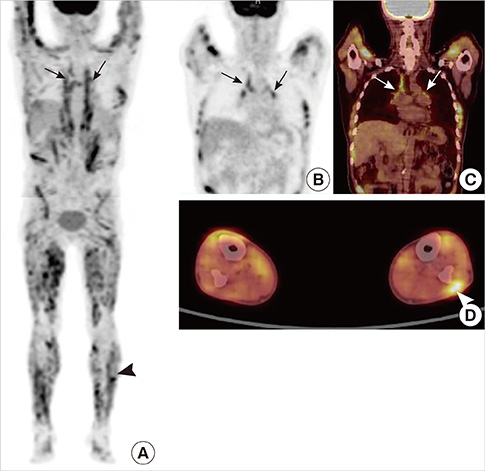J Korean Med Sci.
2013 Sep;28(9):1399-1402. 10.3346/jkms.2013.28.9.1399.
Muscular Sarcoidosis Detected by F-18 FDG PET/CT in a Hypercalcemic Patient
- Affiliations
-
- 1Department of Radiology, College of Medicine, The Catholic University of Korea, Seoul, Korea.
- 2Department of Internal Medicine, College of Medicine, The Catholic University of Korea, Seoul, Korea. drkhs@catholic.ac.kr
- KMID: 1793060
- DOI: http://doi.org/10.3346/jkms.2013.28.9.1399
Abstract
- Sarcoidosis is a systemic granulomatous disease of unknown etiology that involves many organs, occasionally mimicking malignancy. We herein report a 50-yr-old woman of muscular sarcoidosis of chronic myopathic type, manifested by hypercalcemia and muscle wasting. Besides insignificant hilar lymphadenopathy, her sarcoidosis was confined to generalized atrophic muscles and therefore, F-18 FDG PET/CT alone among conventional imaging studies provided diagnostic clues for the non-parathyroid-related hypercalcemia. On follow-up PET/CT during low-dose steroid treatment, FDG uptake in the muscles disappeared whereas that in the hilar lymph nodes remained. PET/CT may be useful in the evaluation of unexpected disease extent and monitoring treatment response in suspected or known sarcoidosis patients.
Keyword
MeSH Terms
-
Female
Fluorodeoxyglucose F18/*diagnostic use
Humans
Hypercalcemia/complications/*diagnosis
Kidney Calculi/complications/diagnosis
Lymph Nodes/radionuclide imaging
Middle Aged
Positron-Emission Tomography
Radiopharmaceuticals/*diagnostic use
Sarcoidosis/complications/drug therapy/*radionuclide imaging
Steroids/therapeutic use
Tomography, X-Ray Computed
Fluorodeoxyglucose F18
Radiopharmaceuticals
Steroids
Figure
Reference
-
1. Vardhanabhuti V, Venkatanarasimha N, Bhatnagar G, Maviki M, Iyengar S, Adams WM, Suresh P. Extra-pulmonary manifestations of sarcoidosis. Clin Radiol. 2012; 67:263–276.2. Spagnolo P, Luppi F, Roversi P, Cerri S, Fabbri LM, Richeldi L. Sarcoidosis: challenging diagnostic aspects of an old disease. Am J Med. 2012; 125:118–125.3. Silverstein A, Siltzbach LE. Muscle involvement in sarcoidosis: asymptomatic, myositis, and myopathy. Arch Neurol. 1969; 21:235–241.4. Marie I, Lahaxe L, Vera P, Edet-Samson A. Follow-up of muscular sarcoidosis using fluorodeoxyglucose positron emission tomography. QJM. 2010; 103:1000–1002.5. Tohme-Noun C, Le Breton C, Sobotka A, Boumenir ZE, Milleron B, Carette MF, Khalil A. Imaging findings in three cases of the nodular type of muscular sarcoidosis. AJR Am J Roentgenol. 2004; 183:995–999.6. Costabel U. Skeletal muscle weakness, fatigue and sarcoidosis. Thorax. 2005; 60:1–2.7. Newman LS, Rose CS, Maier LA. Sarcoidosis. N Engl J Med. 1997; 336:1224–1234.8. Conron M, Young C, Beynon HL. Calcium metabolism in sarcoidosis and its clinical implications. Rheumatology (Oxford). 2000; 39:707–713.9. Richmond BW, Drake WP. Vitamin D, innate immunity, and sarcoidosis granulomatous inflammation: insights from mycobacterial research. Curr Opin Pulm Med. 2010; 16:461–464.10. Baughman RP, Lower EE, du Bois RM. Sarcoidosis. Lancet. 2003; 361:1111–1118.11. Studdy PR, Lapworth R, Bird R. Angiotensin-converting enzyme and its clinical significance: a review. J Clin Pathol. 1983; 36:938–947.12. Meller J, Sahlmann CO, Scheel AK. 18F-FDG PET and PET/CT in fever of unknown origin. J Nucl Med. 2007; 48:35–45.13. Solav SV. FDG PET/CT in evaluation of pyrexia of unknown origin. Clin Nucl Med. 2011; 36:e81–e86.14. Cecchin D, Motta R, Zucchetta P, Bui F, Basso SM, Lumachi F. Imaging studies in hypercalcemia. Curr Med Chem. 2011; 18:3485–3493.15. Culverwell AD, Scarsbrook AF, Chowdhury FU. False-positive uptake on 2-[18F]-fluoro-2-deoxy-D-glucose (FDG) positron-emission tomography/computed tomography (PET/CT) in oncological imaging. Clin Radiol. 2011; 66:366–382.16. Braun JJ, Kessler R, Constantinesco A, Imperiale A. 18F-FDG PET/CT in sarcoidosis management: review and report of 20 cases. Eur J Nucl Med Mol Imaging. 2008; 35:1537–1543.17. Aide N, Benayoun M, Kerrou K, Khalil A, Cadranel J, Talbot JN. Impact of [18F]-fluorodeoxyglucose ([18F]-FDG) imaging in sarcoidosis: unsuspected neurosarcoidosis discovered by [18F]-FDG PET and early metabolic response to corticosteroid therapy. Br J Radiol. 2007; 80:e67–e71.18. Nishiyama Y, Yamamoto Y, Fukunaga K, Takinami H, Iwado Y, Satoh K, Ohkawa M. Comparative evaluation of 18F-FDG PET and 67Ga scintigraphy in patients with sarcoidosis. J Nucl Med. 2006; 47:1571–1576.19. Sohn HS, Kim EN. A case of muscular sarcoidosis diagnosed by gallium-67 scintigraphy and magnetic resonance imaging. Korean J Nucl Med. 1999; 33:543–548.20. Lee JH, Lim YJ, Lee S, Joo KB, Choi YY, Park CK, Lee YH. Early-onset childhood sarcoidosis with incidental multiple enchondromatosis. J Korean Med Sci. 2012; 27:96–100.
- Full Text Links
- Actions
-
Cited
- CITED
-
- Close
- Share
- Similar articles
-
- A Case of Incidentally Detected Nasopharyngeal Tuberculosis on F-18 FDG PET/CT
- The Role of Multimodality Imaging in Cardiac Sarcoidosis
- Growing Cardiac Hemangioma on Serial F-18 FDG PET/CT
- F-18 FDG PET/CT Finding in Solid Pseudo-papillary Tumor of the Pancreas 6 years After Initial Diagnosis
- Multiple Skeletal Muscle Metastases in a Case of Transitional Cell Carcinoma of Bladder Detected by F-18 FDG PET/CT




